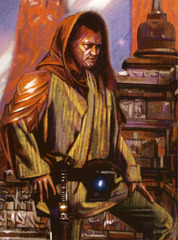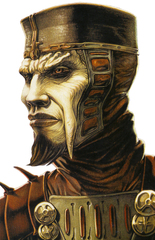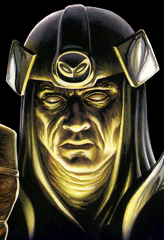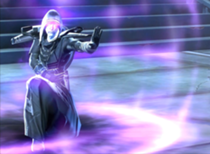Legends Galactic History 103: The Ascension of the Sith Empire
1. Introduction
Welcome, students, to this third course in the Shadow Academy’s grand survey of the history of our forebears. Previously, we have discussed the formation of the galaxy, the creation of the Galactic Republic, and the so-called protectors of the Republic, the Jedi Order. Today, we delve into a topic close to many of our hearts: the origins of the Sith. Throughout the course, there will be opportunities for further research. Though you will not be tested on material found in these “Further Reading” sections, they offer additional information you could find useful or interesting.
2. The Pre-Republic Sith Empire (28,000 BBY - 6,900 BBY)

The first collection of Sith calling themselves the Sith Empire formed on the planet Korriban (later known by the name Moraband) by a black-skinned member of the Sith species named Adas around 28,000 BBY. Adas worked to unite the various Sith, who had previously banded together in tribes and were engaged in a constant struggle against each other. After some time, he was successful in this endeavor and named himself King of the Sith, taking the title of Sith’ari, or Lord of the Sith.
When the Rakata of the Infinite Empire arrived on Korriban around 27,700, King Adas led his unified Sith against the invaders. During the invasion, he was betrayed by one of his own, a Sith named Yshaar Kael, but the Sith were still able to repel the Rakata. In the process of forcing them from Korriban, the ancient Sith learned how to harness the Dark Side of the Force as well as travel the stars, both learned from their failed invaders. With no strong leader like Adas to lead them, the Sith fell into civil war for millennia; a Sith named Hakagram Graush attempted to take up the mantle of Sith’ari sometime before 6,900 BBY, but after a brief period he, too, was ultimately unsuccessful. Though this first attempt at a Sith Empire collapsed upon Adas’ death, the legacy he left - of Sith empowered by the Dark Side and capable of interstellar travel - would be vital to later attempts.
Further reading:
* Ziost
* Korriban
3. The Old Sith Empire (6,900 BBY - 5,100 BBY)

Following their defeat at the Battle of Corbos, which ended the Hundred-Year Darkness - a period of fighting between the Jedi Order and Dark Jedi - a group of fallen Jedi were exiled from known space. Shortly into their period of exile, they stumbled upon Korriban and a nearby planet, Ziost. Sometime after the death of King Adas, the Sith of Korriban had largely abandoned their home and made Ziost their new homeworld, so the exiled Dark Jedi found the primitive but Force-sensitive Sith a perfect target for subjugation. The Dark Jedi were able to use their knowledge of the Force to so thoroughly impress the Sith that they were elevated to god-like status and became their rulers.
With time, the two groups - Sith and Dark Jedi - intermarried to such an extent that the term “Sith” came to be used not only for the pure-blooded Sith species but the Dark Jedi. These hybrid Sith became rulers of a Sith Empire and set up Ziost as their capital with Korriban a series of sacred tombs. This new ruling class became known by the title “Sith Lord,” and one of the first to take up the mantle was a fallen Jedi named Ajunta Pall who led this Empire as the first “Dark Lord of the Sith”.
Further reading:
* Ajunta Pall
4. The Great Hyperspace War (5,100 BBY - 5,000 BBY)
One of the greatest of the early Dark Lords of the Sith was Marka Ragnos, a direct descendent of one of the original fallen Jedi and ruler of the Sith Empire around 5,100 BBY. Upon his death in 5,000 BBY, two Sith Lords, Naga Sadow and Ludo Kressh, vied for the title of Dark Lord, with Sadow overcoming Kressh and taking the mantle of leadership.
An interesting sidenote to the events of this period is that of the origins of Okemi, a name those familiar with the history of the Dark Brotherhood might recognize. Originally a Sith Lord under Marka Ragnos, Okemi grew disillusioned with what he considered to be the half-breed Ragnos and organized a slave rebellion. The rebellion was unsuccessful, and Okemi was exiled to the planet Antei.
Further reading:
* Okemi Uprising
Shortly after Sadow took power, two hyperspace explorers from the Galactic Republic, Gav and Jori Daragon, accidentally stumbled onto Korriban. A conclave of Sith Lords led by Kressh, learning of the Republic for the first time, tried the Daragons as spies and sentenced them to death. Sadow, however, had use of the twins and masterminded their escape while planting evidence that the Republic had gotten them out. He hid them in his fortress until Ludo Kressh discovered what he had done and launched an attack to recapture the Daragons. Though he kept Gav Daragon (who he had been training in the ways of the Dark Side), Sadow allowed Jori to escape after secretly planting a homing device on her ship. Though she was successful in warning Empress Teta of the Koros system, the Republic on Coruscant refused to listen. After soundly defeating his rival Kressh, the Dark Lord of the Sith followed the beacon to Republic space and began his invasion.

Once in Republic space, Naga Sadow sent Gav Daragon with an attack fleet to Koros while the Sith Lord set up his meditation sphere near Primus Goluud, a red-giant star. Using Battle Meditation, he controlled the forces attacking numerous planets, including Coruscant. At the Battle of Koros, Gav Daragon’s sister attacked him with a lightsaber given to her by the Jedi Odan-Urr. Gav fled his sister and returned to Sadow, opening fire on his meditation sphere and breaking his concentration on the invasion of Coruscant. This lapse allowed the Republic forces on Coruscant to rally and push back the Sith.
Jori and Empress Teta returned to Koros at the head of a large fleet. Sensing his defeat, Naga Sadow fired a superweapon at Primus Goluud, causing it to go supernova, and fled the system, allowing Gav Daragon to assume command. Angered at the betrayal by his master, Gav transferred the coordinates of Korriban to Empress Teta before being consumed by the exploding star.
When Sadow returned to Korriban space, he discovered Kressh - who the Dark Lord thought dead - was alive, and their two fleets opened fire on each other. Kressh was finally killed when one of Sadow’s ships crashed into his own shortly after the Republic armadas came out of hyperspace. The Republic ships were able to easily dispatch the warring Sith, shattering them and nearly causing them to go extinct. Sadow fled with his personal guard of Massassi Warriors to Yavin IV, using Sith sorcery to put his body into stasis. The Sith Empire, though not annihilated, was broken, and it would be some time before they would return.
Further reading:
* Massassi
* Empress Teta
4.1 Freedon Nadd

Freedon Nadd began as a Jedi Padawan on the planet Ossus sometime before 4400 BBY, but his lust for power led him to murder his Master. After the murder, he fled Ossus and travelled through the remnants of the Sith Empire. Over time, he found himself on the jungle moon of Yavin IV where he discovered the ancient Dark Lord of the Sith Naga Sadow. Nadd apprenticed himself to Sadow, who taught him a great deal of the Dark Side, making him stronger and stronger. Nadd eventually grew strong enough that he was able to murder another Master, ending Naga Sadow’s long life.
Using his mastery of the Dark Side, Nadd crowned himself king of the planet Onderon where he ruled until his death sometime before 4000 BBY. His body was placed in a tomb below the palace in the capital city, Iziz, but his spirit remained. Even though he was physically dead, he was wildly influential, especially during the long-running Beast Wars between the citizens of Iziz who pledged support to the Dark Lord and those who hadn’t. The Jedi Order was forced to interfere, bringing a halt to Nadd’s influence with their defeat of Queen Amanoa; however, this was short lived as her husband, King Ommin, was able to summon Nadd’s spirit and reinvigorate the Naddist cult that had arisen around his memory. The Jedi again intervened and exiled Nadd’s spirit from Onderon to Dxun, its jungle moon, where he would continue to exert diminished influence.
Further reading:
* Onderon
* Dxun
5. Third Great Schism (4250 BBY)
The Third Great Schism was a period of internal strife within the Jedi Order, pitting Jedi who remained true to the Light Side against those influenced by the teachings of the Sith and fallen to the Dark Side. There was bitter fighting on Coruscant, but the Dark Jedi were eventually pushed back to the Vultar system.
They discovered ancient technology used to create the planets of the system - likely left there by the ancient Celestials - and attempted to use them, specifically one machine called the Cosmic Turbine. They were unable to successfully use the artifacts to further their power, inadvertently annihilating themselves and the entire system in the process, an event that became known as the Vultar Cataclysm. Though the Dark Jedi were dead of their own actions, the memory of the Third Great Schism would continue on, eventually leading - according to the Jedi Order - to both the Great Sith War and the Jedi Civil War hundreds of years later.
6. Rebuilding an Empire (5000 BBY - 3950 BBY)

While the Sith were fighting the Republic during the Great Hyperspace War, one Sith Lord - Vitiate - avoided conflict. Vitiate, who had been elevated to the rank of Sith Lord at the age of thirteen by then-Dark Lord of the Sith Marka Ragnos, ruled his homeworld of Medriaas, which he renamed Nathema. In 5,000 BBY, after the Old Sith Empire had fallen to the Republic, Vitiate invited all surviving Sith Lords to Nathema with the promise of a solution to the problem of the Jedi. Instead, he turned on his fellow Lords and used their strength to conduct a dark ritual that made him immortal at the cost of every living thing on the planet.
Proclaiming himself the next Sith Emperor, Vitiate gathered the scattered forces of the Empire and led them on a journey into the Unknown Regions. There, he discovered Dromund Kaas, which he used to form the capital of his reformed Sith Empire. From this new seat of power, the Sith Emperor put into motion numerous plots, all geared toward elevating him to the status of god. However, the ancient Sith Lords entombed on Korriban strongly disagreed with Vitiate and his actions, and in retribution for his refusal to submit to them chose Exar Kun, a fallen Jedi who had studied under the spirit of Freedon Nadd, to lead the Sith. The two competing factions of the Sith would feature heavily in the events that began to unfold during the Great Sith War.
7. Conclusion
And thus we draw to a close the beginnings of the Sith. As you likely understand, the history of the Sith is far from over, so we invite you to continue your studies. Now, prepare for your exam to showcase your mastery of the information provided.
Information for this course was researched using:
* Wookieepedia
Please log in to take this course's exam